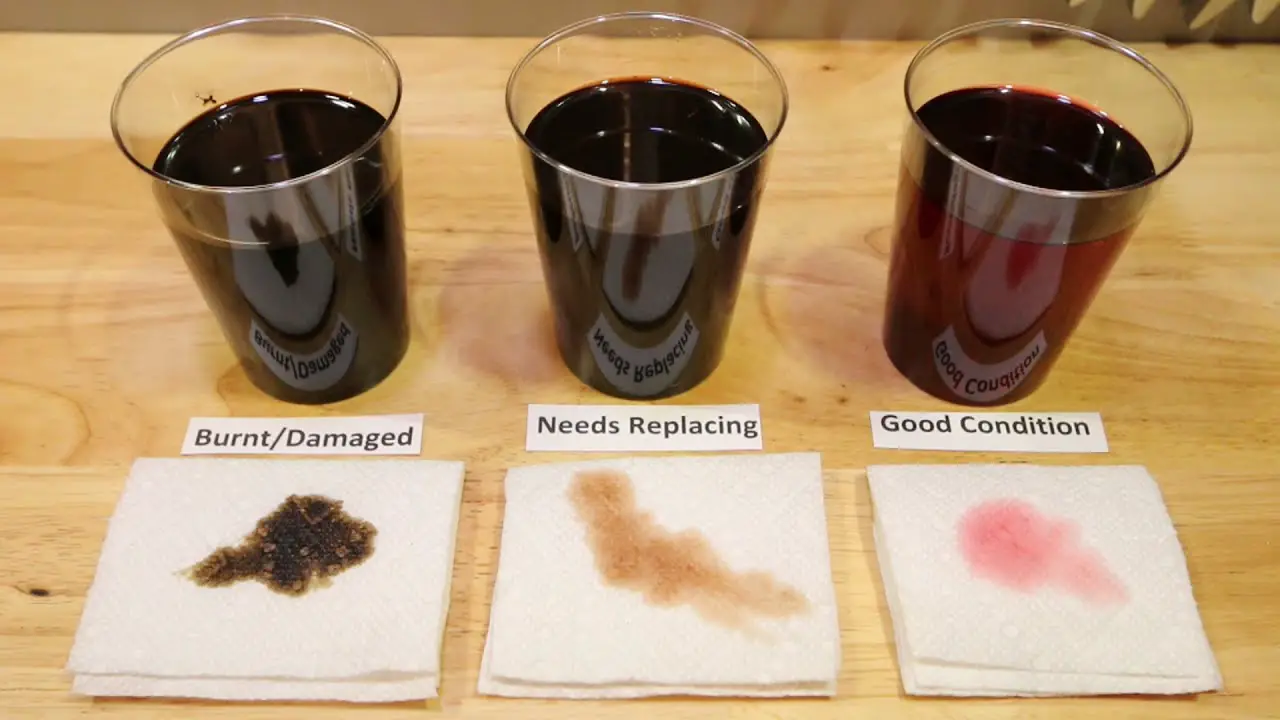Transmission fluid should be a bright red color. It should not have any darkening, cloudiness, or other discoloration. The consistency of transmission fluid should be thick and oily with no visible metallic particles or debris.
If the transmission fluid is brownish-red in color then it could indicate that the fluid has been contaminated by water. This would require that the old fluid is drained out and new transmission fluid filled in its place to ensure proper lubrication of components within the system. Additionally, if there are signs of metal shavings or particles mixed into the transmission oil then this can also signal an internal problem such as bearing failure and requires immediate attention from a qualified mechanic before further damage occurs.
When it comes to transmission fluid, you should always check the color of your car’s transmission fluid. The ideal color for transmission fluid is a bright red hue, as this indicates that the fluid has been recently changed and is in good condition. If the fluids appear dark or even black in color, then it’s time to have them serviced by an experienced technician and replaced if necessary.
Additionally, you should also be on the lookout for any discolored patches or particles within your vehicle’s transmission system which could indicate a more serious issue.
What Does Bad Transmission Fluid Look Like? Good vs Bad
What Color Should Transmission Fluid Be on Dipstick?
The color of transmission fluid on the dipstick should be bright red, indicating that it is in good condition. If the fluid appears black, brown or discolored, this could indicate that it needs to be changed as soon as possible. Additionally, if there are any metal particles or debris present in the fluid when examined with a magnet, this may also indicate that the transmission requires service and may need to have its fluids changed.
How Do You Know If Your Transmission Fluid Needs to Be Changed?
If you want to know if your transmission fluid needs to be changed, it’s important to check the dipstick regularly. If the fluid is dark in color or has a burnt smell, then it’s likely that the transmission fluid needs to be changed. Other signs include difficulty shifting gears, delayed engagement when shifting from park into drive, and noises coming from the engine while accelerating or decelerating.
If any of these symptoms are present, it’s time for a transmission flush and refill with fresh fluid as soon as possible.
What Color is Healthy Transmission Fluid?
Transmission fluid is typically red in color, which indicates that it is healthy. If the fluid has a brownish or black appearance, this could signify that there are contaminants present or that the fluid has exceeded its lifespan and should be replaced as soon as possible. Additionally, transmission fluid may take on a pinkish hue when exposed to high temperatures over time – another indication of contamination or wear and tear.
Healthy transmission fluid should not contain any visible particles and should have an odor similar to diesel fuel.
What Should Transmission Fluid Look Like on Dipstick?
Transmission fluid should be a clear or slightly pinkish color when checked with the dipstick. It should also be free of any debris, such as metal shavings, and have no burnt odor. If the transmission fluid is dark in color, has a burnt smell to it or contains metal pieces, then it is likely that there are serious problems within the transmission and should be attended to immediately by a qualified mechanic.
Additionally, if the level of transmission fluid on the dipstick appears low then it may indicate that there is an issue with either a leak or low levels due to insufficient topping up over time; this too requires professional attention.

Credit: mechanics.stackexchange.com
What Does Yellow Transmission Fluid Mean
Yellow transmission fluid can indicate that it is time to change your transmission fluid. The color of the fluid begins as bright red when new and darkens over time due to normal use and heat exposure. If you’re noticing a more yellowish hue, this means that your transmission has been accumulating dirt particles and other contaminants, which could cause serious problems if left unchecked.
It’s important to regularly check the condition of your vehicle’s fluids to ensure they are operating at peak performance levels.
Light Brown Transmission Fluid
Light brown transmission fluid indicates that the fluid is in good condition and should be monitored for any changes in color or texture. This type of fluid is typically seen on newer vehicles, as it contains additives that help protect against wear and tear. It’s important to regularly check your vehicle’s transmission fluid level and its color, so you can make sure the system runs properly.
If light brown transmission fluid turns darker or has a burnt smell, then it may indicate there’s a problem with the transmission and it needs to be serviced immediately by an experienced mechanic.
Clear Transmission Fluid
Transmission fluid is essential for the proper functioning of a vehicle’s transmission, providing lubrication and cooling to internal components. Clear transmission fluid helps keep your car running smoothly and efficiently by reducing friction between parts, as well as helping to protect against corrosion and wear. It also has detergent properties which help reduce dirt build up in the transmission system.
Regularly checking the level of this fluid can help you identify potential problems before they become major issues.
Conclusion
Overall, it is important to be aware of the color of your vehicle’s transmission fluid and what this may indicate. If the transmission fluid appears dark or discolored, then it should be replaced as soon as possible. Additionally, regular checking and maintenance will ensure a long-lasting life for your car’s transmission system.
Knowing when to check the condition of your transmission fluid can help you save money in costly repairs down the road.



